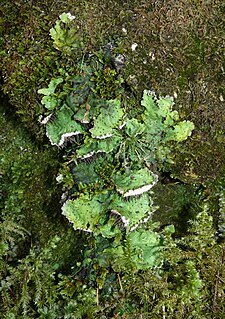
Peltigera is a genus of approximately 100 species of foliose lichens in the family Peltigeraceae. Commonly known as the dog or pelt lichens, species of Peltigera are often terricolous, but can also occur on moss, trees, rocks, and many other substrates in many parts of the world.
Gastón Guzmán Huerta, a Mexican mycologist and anthropologist, was an authority on the genus Psilocybe.

Punctelia is a genus of foliose lichens belonging to the large family Parmeliaceae. The genus, which contains about 50 species, was segregated from genus Parmelia in 1982. Characteristics that define Punctelia include the presence of hook-like to thread-like conidia, simple rhizines, and point-like pseudocyphellae. It is this last feature that is alluded to in the vernacular names speckled shield lichens or speckleback lichens.
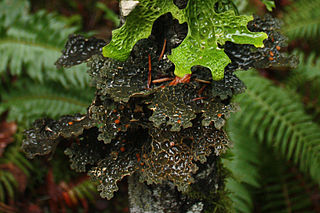
Pseudocyphellaria is a genus of large, leafy lichens that are sometimes referred to as "specklebelly" lichens. The genus has a widespread distribution, especially in south temperate regions, and contains about 170 species. They resemble Lobaria, except that most species of Pseudocyphellaria have conspicuous pseudocyphellae on their lower surface, a characteristic that was once considered unique to this genus. Some species contain pulvinic acid-related pigments; in these species the soredia and pseudocyphellae can be bright yellow.
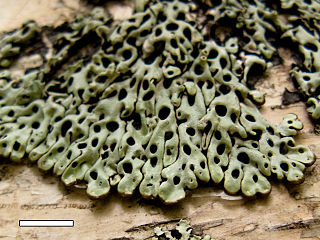
Menegazzia is a genus of lichenized fungi containing roughly 70 accepted species. The group is sometimes referred to as the tree flutes, honeycombed lichens, or hole-punch lichens. The most obvious morphological feature of the genus is the distinctive perforations spread across the upper side of the thallus. This makes the group easy to recognise, even for those not particularly familiar with lichen identification.
Menegazzia inflata is a species of foliose lichen found in New Zealand. Originally described as a species of Parmelia in 1940, it was transferred to the genus Menegazzia in 1983.

Harry Howard Barton Allan was a New Zealand teacher, botanist, and writer. Despite never receiving a formal education in botany, he became an eminent scientist, publishing over 100 scientific papers, three introductory handbooks on New Zealand plants, and completing the first volume of a flora in his lifetime.
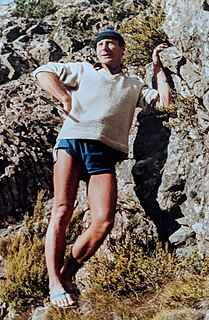
John Kenneth Bartlett was a New Zealand plant collector and botanist who specialised in mosses, liverworts, and lichens. In 1974, he found Bartlett's rātā growing south-east of Cape Reinga.
Rolf Santesson (1916–2013) was a Swedish lichenologist and university lecturer. He was awarded the Acharius Medal in 1992 for his lifetime contributions to lichenology.
David John Galloway, FRSNZ was a biochemist, botanist, and lichenologist.

Gunnar Bror Fritiof Degelius was a Swedish lichenologist. Between the publications of his first and final scientific papers, Degelius had a 70-year-long research career. While he was best known for his expertise on the lichen genus Collema, he also wrote important papers on lichen biology and ecology, floristic studies of the Nordic countries and various other areas around the world, and lichen succession. Degelius described 124 new taxa, and published about 130 scientific papers. In 1992 he was one of the first to be awarded the Acharius Medal for his lifetime contributions to lichenology. Fifteen species and three genera have been named in honour of Degelius.

Punctelia reddenda is a widely distributed species of foliose lichen in the family Parmeliaceae. It occurs in Africa, Europe, North America, and South America, where it grows on bark and on rock.
Punctelia subalbicans is a species of foliose lichen in the family Parmeliaceae. It is found in Australia and New Zealand, where it grows on the bark of various tree species.

Roccellinastrum is a genus of lichen-forming fungi in the family Pilocarpaceae. It has seven species.

Punctelia borreri is a species of foliose lichen in the family Parmeliaceae. It is a common and widely distributed species, occurring in tropical, subtropical, and temperate regions of Africa, Asia, Europe, North America, Oceania, and South America. The lichen typically grows on bark of deciduous trees, and less commonly on rock. Some European countries have reported increases in the geographic range or regional frequency of the lichen in recent decades, attributed alternatively to a reduction of atmospheric sulphur dioxide levels or an increase in temperatures resulting from climate change.
Geoffrey Charles Bratt was an Australian chemist and lichenologist.
Pseudocyphellaria brattii is a species of foliose lichen in the family Lobariaceae. It was described as new to science in 1997 by lichenologists David John Galloway and Gintaras Kantvilas. The type specimen was collected along Mt. Dundas Track (Tasmania), where it was found growing on dead wood in a rainforest at an altitude of 700 m (2,300 ft). The specific epithet honours Tasmanian lichenologist Geoffrey Charles Bratt, who, according to the authors, "helped to keep Australian lichenology alive during the 'lean years'".
Menegazzia gallowayi is a species of lichen in the family Parmeliaceae. Found in New Zealand, it was formally described as a new species in 2012 by Australian lichenologist Gintaras Kantvilas. The type specimen was collected near the Craigieburn stream at an altitude of 1,050 m (3,440 ft). Here it was found growing on a young mountain beech. The specific epithet honours New Zealand lichenologist David John Galloway. According to Kantvilas, his work Flora of New Zealand Lichens has "greatly advanced knowledge of the lichens of the Southern Hemisphere".
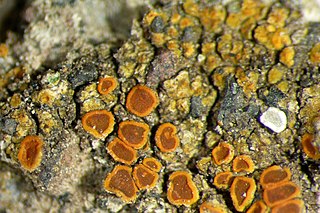
Caloplaca allanii is a species of saxicolous (rock-dwelling) and crustose lichen in the family Teloschistaceae. Found in New Zealand, it was formally described as a new species by Alexander Zahlbruckner. The type specimen was collected by Lucy Cranwell on Anawhata Beach in 1932; she sent a dried specimen to Zahlbruckner for identification. The specific epithet allanii honours New Zealand botanist Harry Allan.
Pertusaria allanii is a species of saxicolous (rock-dwelling) and crustose lichen in the family Pertusariaceae. Found in New Zealand, it was scientifically described as a new species in 1941 by Austrian-Hungarian lichenologist Alexander Zahlbruckner. The type specimen was collected from Waiheke Island, where it was found growing on coastal rock. The specific epithet allanii honours the collector, New Zealand botanist Harry Allan. As of 2018, in the New Zealand Threat Classification System, the lichen is considered "At Risk – Naturally Uncommon".









